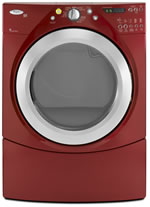Clothes Dryer Buying Guide:
How to Choose a New Dryer
 |
Clothes Dryers have changed very little over the past fifty years. They are simple appliances with simple operations and simple mechanisms. Unlike washing machines, which are one of the most complicated pieces of equipment in most homes, dryers have only a few moving parts and few or no electronic parts.
People often replace their dryer when they replace a washing machine. The thing is, the lifespan of a typical dryer well exceeds the lifespan of a washer and so replacement of the dryer may be an unnecessary expense. Justification for replacement because the new appliance is equipped with all the latest bells and whistles doesn't really apply here, because dryers don't have many new features available. Two exceptions are moisture sensors and some possible improvement in energy efficiency.
If you do replace a clothes dryer, there are some things to look for, and we'll detail those below. First though, consider whether to purchase a gas or electric dryer. A gas dryer costs a little more up front, but is generally cheaper to operate; making it cheaper overall, long term. Another consideration is what energy source is already available where the dryer will be placed. Electric dryers require 240V outlets, while gas dryers a gas line to the laundry area. Running new service to the laundry area shouldn't be too difficult, but will add at least a couple hundred dollars to your costs. For more information on choosing between a gas or electric dryer see out article "Gas versus Electric".
Features to Look for in a Clothes Dryer
Dryers tumble clothes while passing air over them. The air carries away moisture leaving the clothes dry. Warm air accomplishes the drying more quickly. This is a pretty simple process. In the past, all dryers used a timer to end the drying cycle, whether the clothes were dry or not. Even if the clothes were completely dry, the timer would continue the cycle, wasting energy and potentially damaging clothes by over-drying. Now, with the introduction of a moisture sensor, the dryer to shut itself off, when it senses that the clothes are dry.
Moisture sensors are the single most important feature to look for on a new dryer. Fortunately, they can be found even on some of the least expensive models. A moisture sensor monitors the moisture of the air as it leaves the dryer. When the levels drop low enough, the dryer shuts off. Dryers should also have a control that works with the moisture sensor labelled something like "Less Dry - More Dry". This control allows you to ensure that the clothes are properly dry and not overly moist or overly dry.
Quiet operation is another feature that may be important to some. If the dryer is in a part you home, far from where people are, then it may not be a consideration. However, laundry areas near the kitchen or family room can be a real annoyance to everyone while the washer and dryer are running. Look for manufacturer ratings for quiet operation. A numerical rating should be in "sones". A rating of "4" would be equal to normal conversation, while a rating of "1" would be equivalent to the average refrigerator operating.
Adequate capacity is another important feature. The only real disadvantages to the largest capacity dryers is the size of the dryer and possibly higher purchase price. Efficiency wise, a large capacity model will dry small loads more quickly and thus should not cost more to operate. The advantages of a large capacity dryer are, the ability to accommodate bulky items like comforters and the ability to dry a load more quickly.
Wrinkle-free features are helpful because after the dryer cycle stops, every few minutes it tumbles the clothes. It will periodically tumble the clothes until you have time to take them out. This allows you to start the dryer and leave the house, without having to worry about home a load of wrinkled clothes.
Over Rated Features
Higher end dryers add features such as a large number different cycles and settings. All the elaborate settings options are simply preset heat and time combinations. The fact is, a basic high-low-off heat setting, coupled with a timer and an "automatic" setting are all that are really needed to get the done. The array of presets doesn't really add much in the way of convenience or results.
Another unnecessary feature of some higher end dryers is a stainless steel drum. The added cost is unwarranted because dryers don't experience the same problems as washers in regard to chipping and rusting. Dryers don't having standing water or moisture to lead to rust problems and so a stainless steel drum adds no valuable benefit.
Touch pad controls look cool, but they add cost over simpler mechanical controls. Also, the likelihood for repairs is higher with electronic controls than for mechanical controls.





